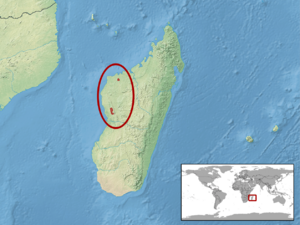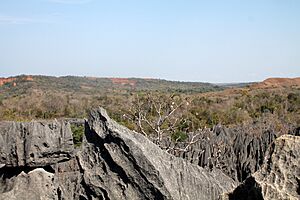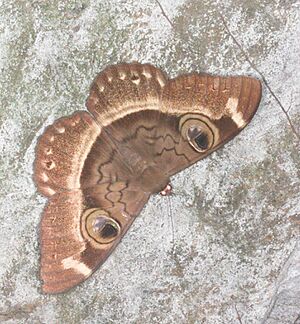Paroedura tanjaka facts for kids
Quick facts for kids Paroedura tanjaka |
|
|---|---|
| Conservation status | |
| Scientific classification | |
| Genus: |
Paroedura
|
| Species: |
tanjaka
|
 |
|
| Approximate distribution of Paroedura tanjaka | |
The Paroedura tanjaka is a type of lizard that belongs to the Gekkonidae family, which includes geckos. This special gecko lives only in the northwestern part of Madagascar, an island country. It has only been found in two areas called Bemaraha and Namoroka.
This gecko is active at night, meaning it's a nocturnal animal. It lives in dry forests that have lots of limestone rocks. During the day, it likes to hide in caves. It's one of the biggest geckos in its group, called Paroedura, and can grow up to 18 centimeters long.
Scientists first found this gecko in 1996 and gave it its official name in 2000. Because it lives in a very small area and its home is shrinking, it is listed as Endangered by the IUCN Red List. This means it's at high risk of disappearing forever. Even though there aren't specific plans just for this gecko, the places where it lives are protected as national parks.
Contents
About the Paroedura tanjaka
The Paroedura tanjaka gecko was officially named in 2000 by scientists Nussbaum and Raxworthy. The first gecko specimen used to describe the species, called a holotype, was a grown-up male found in the Bemaraha Nature Reserve in Madagascar in 1996. Other geckos from Bemaraha and Namoroka were also collected to help describe the species. The name tanjaka comes from the Malagasy language and means "strength."
Scientists have studied the genes of Paroedura tanjaka. They found that it is closely related to another gecko called Paroedura neglecta.
Where It Lives and Its Home
This gecko is one of many animals that live only on the island of Madagascar. It has only been found in two places: Tsingy de Bemaraha and Tsingy de Namoroka. These areas are in the west-central part of the country.
The gecko lives in dry forests with limestone rocks, usually at heights between 100 and 500 meters above sea level. The total area where this gecko is known to live is quite small, about 964 square kilometers. While it might live in a slightly larger area, it's probably not much bigger than 5,000 square kilometers. During the day, these geckos are known to hide inside karst caves in their habitat.
What It Looks Like
This gecko is one of the largest in the Paroedura group. It can grow up to 10.2 centimeters long from its snout to the base of its tail, and its total length, including the tail, can be up to 18 centimeters.
Its head is wider than its neck. The scales on its back are bumpy and not in neat rows. There are smaller bumps and flat scales between the larger ones. Unlike some other geckos in its group, its tail is not spiky. Its toes have wide pads at the end, which are more than twice as wide as the rest of the toe. These pads help it climb.
The gecko's head is a clean tan color and has light lines on the sides, which makes it look different from the rest of its body. Its back is grayish with irregular brown spots and bands. These bands continue onto its tail, but they are lighter if the tail has grown back after being lost. Young geckos have three clear light bands across their body and dark brown or black colors on their back.
How It Behaves
Paroedura tanjaka is a nocturnal animal, meaning it is active at night in its dry forest home. It lives on the ground but can also climb. People have seen it mostly climbing on the bases of tsingy cliffs, which are tall, sharp limestone formations, about 1 to 4 meters high. It also climbs on tree branches and trunks, usually 0.5 to 2.5 meters up.
During the day, this gecko hides in karst caves. The first time scientists saw this gecko during the day was 30 meters inside a cave. Later, many more observations showed these geckos living in caves during the daytime, always in completely dark areas far from the entrance. P. tanjaka is known to hunt and even mate in these caves during the day. Scientists think the darkness of the caves allows these night-active geckos to stay active during the day and avoid animals that might try to eat them.
What It Eats
Like most geckos, Paroedura tanjaka is an insectivorous species, meaning it mainly eats small arthropods like insects and spiders. It hunts for these at night in the limestone forests. Since it stays in caves during the day, and many small invertebrates live in these caves, scientists believe it also hunts inside the caves during the day. Both animals that live only in caves and night-active animals resting to avoid predators or daytime heat (like the moth Cyligramma duplex) are found in these caves and are likely part of the gecko's diet.
Who Eats It
This gecko is known to be eaten by snakes. One gecko was found inside the stomach of a snake called Lycodryas gaimardi. Snakes in the Lycodryas group are generally known to hunt Paroedura geckos. Birds and some mammals might also hunt and eat this species.
Protecting the Species
Because it lives in a very small area and its home is shrinking and broken into smaller pieces, Paroedura tanjaka is listed as Endangered on the IUCN Red List. This means it's at a very high risk of becoming extinct.
Since it lives in such a small area, this gecko is very sensitive to changes in its forest home. Even though there seem to be many of these geckos in Bemaraha, the number of adult geckos is going down. Its habitat is threatened by more intense fires and by people cutting down trees. There are no specific protection plans just for this gecko, but both places where it is known to live, Bemaraha and Namoraka, are national parks. This means they are protected areas, which helps keep the gecko's home safe.




